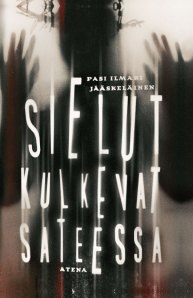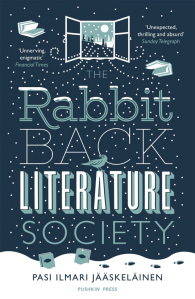Arkistot kuukauden mukaan: heinäkuu 2014
About my latest novel: Souls Walk in the Rain
There are some horror elements in my debut novel The Rabbit Back Literature Society, along with all the other different genre elements it contains (it’s also a detective story, a ghost story and a love story, just to mention a few). Horror elements are there also in my second novel (The Cinematic Life: A Novel, in Finnish: Harjukaupungin salakäytävät) which has not been translated yet, although it is more a love story than anything else – a weird one, of course. But this third novel of mine, Souls Walk in the Rain (it was published in 2013 and hasn’t yet been translated), oh yeah, it is a lovecraftian horror story. And a fantasy story. And a thriller. And a love story. And also my serious attempt to study the very essence of life, death and religion, which of course are the most important themes of all philosophy and art.
I quote Bookthirsty who explains the main premises of the novel in her blog:
Overworked and underpaid Judit leaves her uneventful life and husband for a nursing job with an international organization in Helsinki. Her boss and best friend Martta, mother of her beloved eight year old godson Mauri, has been with the company for many years and explains that the pay and perks are so good because employees are expected to go the extra mile. Nurses are expected to not only take care of the patients’ physical needs, but also that of their souls, something that agnostic Judit has trouble with. She used to believe wholeheartedly as a small child, but hasn’t for years, for reasons which slowly come to light.
Mysterious warnings are sent to her phone in this summer of never-ending rain (the rain never stops in this book, it is even more overwhelming than the snow in The Rabbit Back Literature Society) and for some odd reason she is called upon to treat the so-called ‘king of atheists’, internationally known and controversial, but oh-so-charming Leo Moreau.
This international organization, a big home health care company called F-Remedium, has a device with which it’s possible to revive one’s soul. It’s an important part of the company policies that human souls is an organ that needs to be monitored and treated, not different from all the other organs like heart, lungs or liver. The device they use is called a Persinger device – which actually isn’t just fiction but a real thing: it’s better known as a ”God Helmet”:
The ”God Helmet” refers to an experimental apparatus originally called the ”Koren helmet” after its inventor Stanley Koren. It was developed by Koren and neuroscientist Michael Persinger to study creativity and the effects of subtle stimulation of the temporal lobes. Reports by participants of a ”sensed presence” while wearing the God helmet brought public attention and resulted in several TV documentaries. The device has been used in Persinger’s research in the field of neurotheology, the study of the neural correlates of religion and spirituality. The apparatus, placed on the head of an experimental subject, generates very weak fluctuating magnetic fields, that Persinger refers to as ”complex.” These fields are approximately as strong as those generated by a land line telephone handset or an ordinary hair dryer, but far weaker than that of an ordinary refrigerator magnet and approximately a million times weaker than transcranial magnetic stimulation.
Persinger reports that many subjects have reported ”mystical experiences and altered states”while wearing the God Helmet.
Nurse Judit is given an important mission by her best friend and new boss Martta: Judit’s godson is dying, and as his godmother she is obligated to make him believe in God – boy’s mother Martta is a Christian fundamentalist and everything else but happy about the fact that her terminally ill son is an atheist. Judit is an agnosticist and somewhat reluctant to do so, but eventually she has no choice but try to convince the boy about the existence of God in order to give the dying boy at least some hope.
Later Martta learns that Leo Moreau, the king of atheists, is rumoured to have some kind of evidence about the existence of God in his possession. Of course she sends Judit to investigate the rumour and spy Moreau. And so her great adventure to the core of the secret truth about our universe begins…
Like all the other stories I have ever written, Souls Walk in the Rain is inspired by a dream I once had. Or actually by two dreams. The first one was about a trip to the space. Very surrealistic, a little bit scary – and fascinating enough to haunt me for years until I finally started to spin a story around it. The second dream – which I have had quite often – is about climbing endless stairs.
Then there is this woodcut I saw in some dictionary when I was a kid – I just couldn’t forget it, and it was another source of inspiration when writing Souls Walk in the Rain:
In a way the novel is also a celebration of reading literature. There is this mysterious female character, dedicated to all the (wonderful) book bloggers of the world – they truly are sirens of literature, luring people to read more books (and as a writer I consider them to be important allies because books have to compete for the attention of the people with so many things)…
B-format cover of The Rabbit Back Literature Society
This is what the cover of The Rabbit Back Literature Society, published by Pushkin Press in 2013, looks like. I love it. I think it’s very stylish (as do many others), thanks to David Pearson. The B-format version of TRBLS will be published in September 2014 and it’ll have a new cover, designed by Nathan Burton. It’s quite different but as great as the first cover – I really love it (especially the little bird in it is absolutely delightful):
The German translation: LAURAS VERSCHWINDEN IM SCHNEE
Our mailman brought something pleasant this morning: the new catalogue of my German publisher Aufbau Verlag. Pushkin Press published The Rabbit Back Literature Society in November 2013, and I suppose the German translation is the next one to become true in a form of a printed book – and in October I’m supposed to participate the Frankfurt Book Fair among several other Finnish writers (this year Finland is the guest of honour) and naturally LAURAS VERSCHWINDEN IM SCHNEE has to be available by then.







